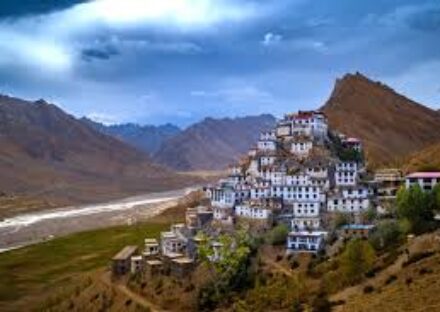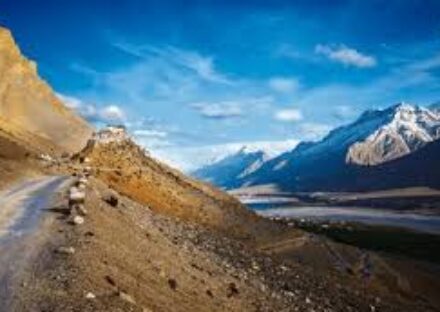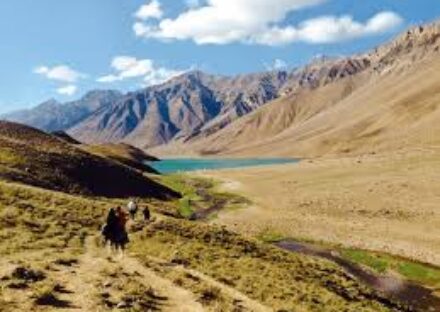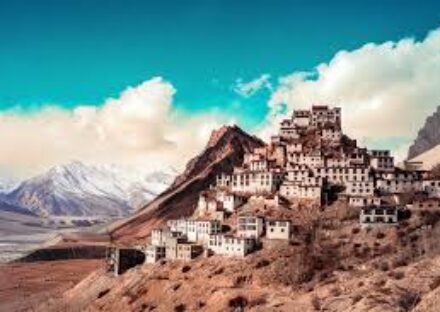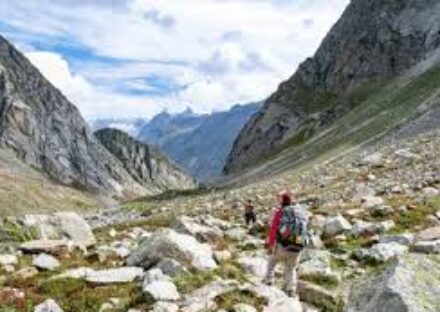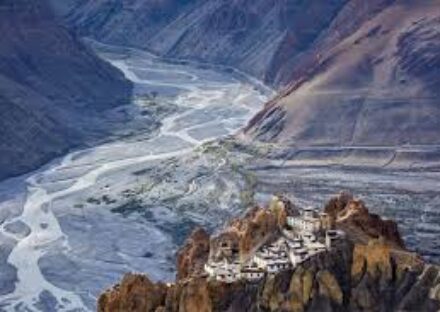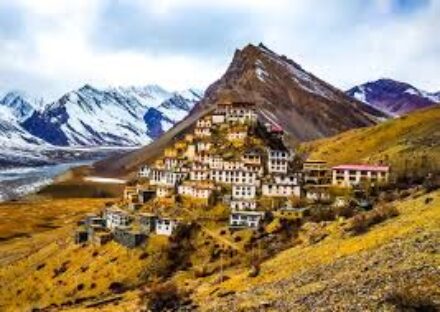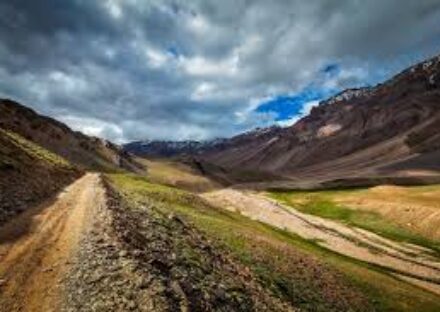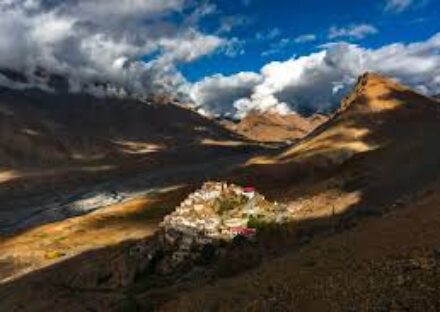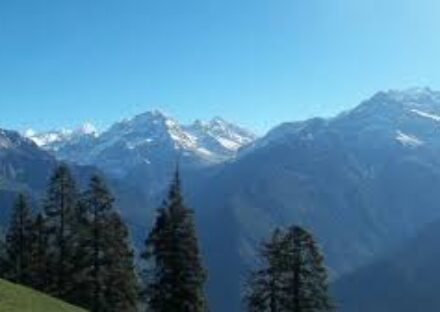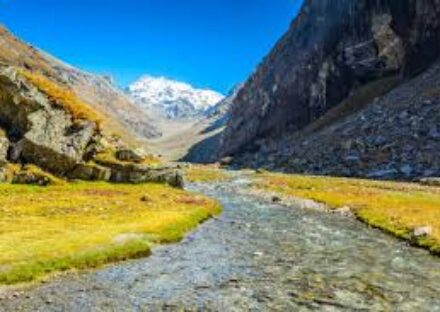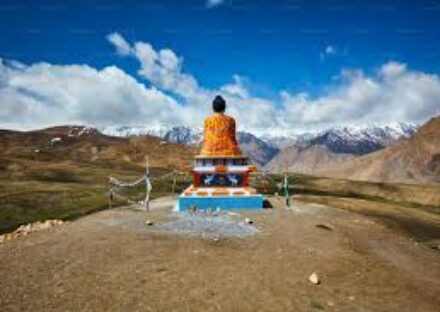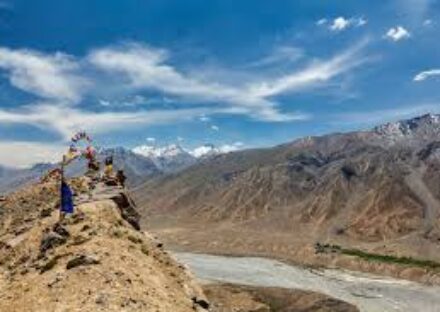- Details
- Photos
Tour overview
Spiti Valley Trek – Overview
The Spiti Valley Trek takes you through one of the most remote and beautiful regions of the Himalayas. Surrounded by tall mountains and ancient culture, Spiti is known as the “Land of Lamas.” The landscapes here are raw, peaceful, and full of natural beauty.
It is not a regular trekking journey. Most of the adventure happens by road, where you explore high mountains, deep gorges, quiet villages, frozen rivers, and monasteries that are centuries old. The experience is perfect for travellers who enjoy nature, culture, photography, and peaceful surroundings.
Spiti offers unforgettable views at every turn. You visit famous spots like Key Monastery, Hikkim Post Office, Komic Village, Langza Buddha Statue, Chicham Bridge, and the stunning Chandratal Lake. Each place has its own unique charm and story.
This journey is suitable for beginners, families, couples, and solo travellers. You do not need trekking experience. The routes are designed to give you comfort, proper acclimatization, and enough time to enjoy every location.
Mountain Hikers offers three seasonal routes—Short Summer Route, Winter Route, and Full Summer Route. Each route gives a different experience of Spiti’s beauty, weather, and culture. No matter which route you choose, the trip promises adventure, calmness, and memories that stay with you forever.
Highlights of the Spiti Valley Trek
Experience a journey through one of the most peaceful and picturesque regions of the Himalayas. Spiti Valley offers a mix of culture, nature, adventure, and high-altitude landscapes that you won’t find anywhere else.
Key Highlights
- Explore ancient monasteries including Key Monastery, one of the oldest and most important in Spiti.
- Visit the world’s highest places like Hikkim Post Office, Komic Village, and Langza with its giant Buddha statue.
- Drive through dramatic landscapes, deep gorges, snow-covered mountains, and wide desert valleys.
- Witness the changing colours of the stunning Chandratal Lake (Full Summer Route).
- Experience peaceful local life in villages that have preserved their traditions for centuries.
- Cross high-altitude passes like Kunzum La (Summer Routes) with breathtaking scenery.
- Capture beautiful photographs of Spiti’s raw and untouched natural beauty.
- Enjoy clear night skies filled with countless stars, perfect for stargazing.
- Travel through both green valleys of Kinnaur and the cold desert of Spiti.
- Comfortable and scenic road journey suitable for beginners and families.
Important Details
- Maximum Altitude: Up to 15,000 ft — prepare for thin air.
- Temperature: Summer 0°C–20°C, Winter -5°C to -20°C.
- Road Conditions: Narrow, off-road, and time-consuming routes.
- Network: Only BSNL works; internet is slow.
- ATMs: Only reliable ATM is in Kaza; carry cash.
- Food: Simple, hot vegetarian meals for easy digestion.
- Accommodation: Clean hotels, homestays, and camps; heating may be limited.
- Vehicles: Tempo Traveller & SUVs driven by expert mountain drivers.
- Health: Stay hydrated; avoid alcohol; rest well for acclimatization.
- Permits: No special permits for Indians; carry valid ID.
- Winter Travel: Routes depend on snowfall; delays possible.
- Water Crossings: Common on Manali–Kaza road in summer.
- Oxygen Support: Backup oxygen cylinder available.
- Emergency: First-aid kit & local team assistance throughout the trip.
- Packing: Always carry warm layers, even in summer.
Cultural Significance
Spiti Valley is home to communities that have preserved their culture for hundreds of years. The people here follow a simple and meaningful way of life, deeply connected to their land and traditions. Their homes, clothing, food, and festivals reflect the true essence of Himalayan culture.
Every village has its own customs passed down from generation to generation. Whether it is celebrating harvest festivals, performing traditional dances, or gathering for community rituals, the people of Spiti keep their heritage alive with pride. Their warm hospitality and kind nature make visitors feel welcome in every corner of the valley.
Spiti’s culture also highlights a strong sense of unity. Villagers support each other during harsh winters and share resources as a community. This simple, close-knit lifestyle offers travellers a unique chance to understand how life flourishes in such remote regions.
Religious Significance
Spiti Valley is one of the most sacred Buddhist regions in India. Monasteries like Key, Tabo, Dhankar, and Komic are centuries old and serve as centres of meditation, learning, and spiritual practice. These monasteries are filled with ancient murals, handwritten scriptures, and peaceful prayer halls that hold deep spiritual value.
Buddhism shapes everyday life in Spiti. Prayer flags flutter across mountain roads, and stupas stand on hilltops offering blessings to travellers. Monks continue to practice traditional rituals, chanting, and meditation that have been followed in this region for centuries.
Many locals believe that the mountains and rivers of Spiti carry spiritual energy. The giant Buddha statue in Langza is seen as a protector of the valley, bringing peace to everyone who visits. For travellers, spending even a few minutes in a monastery or watching the evening prayers feels calming and spiritually refreshing.
Spiti Valley – Short Summer Route Itinerary
Experience the beauty of Spiti Valley in a short and scenic summer route. This itinerary is suitable for travellers who want to explore the major highlights of Spiti in fewer days while enjoying comfortable travel, high–altitude landscapes, ancient monasteries, and peaceful villages.
Day 1: Departure from Delhi / Chandigarh to Manali
Begin your journey through smooth highways and mountain roads as you move closer to the Himalayas. Enjoy the scenic drive, fresh air, and the excitement of entering Himachal’s high-altitude region.
Highlights of the day:
- Drive through beautiful valleys and pine forests
- Enjoy meals along roadside dhabas
- Experience changing landscapes as you climb higher
- Cross small mountain towns and local markets
- Reach Manali by evening
- Settle into your stay and relax
- Explore the nearby area on foot
- Acclimatize to the cool mountain climate
- Enjoy dinner with the group
- Overnight stay in Manali
Day 2: Manali Self-Exploration
Spend a relaxed day in Manali exploring local spots, markets, and riverside views while adjusting your body to the altitude before entering Spiti.
Highlights of the day:
- Walk around Old Manali
- Explore cafés and local food
- Visit Hidimba Temple (optional)
- Enjoy the River Beas viewpoint
- Shopping at Mall Road
- Relax in peaceful mountain surroundings
- Try local Himachali dishes
- Acclimatization day for better comfort
- Group briefing for the next day
- Overnight stay in Manali
Day 3: Manali to Kaza via Atal Tunnel & Kunzum La
A scenic and adventurous drive through some of India’s highest passes. From green valleys to cold desert landscapes, today is a visual treat.
Highlights of the day:
- Pass through the Atal Tunnel
- Witness dramatic landscape changes
- Stop at Gramphu for photo opportunities
- Drive beside Chandra River
- Cross high-altitude passes like Kunzum La
- Visit the small temple on the pass (optional)
- Enjoy packed lunch or dhaba food
- Enter the Spiti Valley region
- Reach Kaza by evening
- Overnight stay in Kaza
Day 4: Explore Key Monastery, Hikkim, Komic & Langza
A full sightseeing day covering Spiti’s most famous and culturally rich villages along with the iconic Key Monastery.
Highlights of the day:
- Visit the ancient Key Monastery
- Explore monastery interiors and prayer halls
- Drive to the world’s highest village – Komic
- Visit Hikkim, home to the world’s highest post office
- Send a postcard to your loved ones
- Enjoy panoramic views of Langza village
- Spot the famous Langza Buddha statue
- Experience the cold desert lifestyle
- Interact with local villagers
- Return to Kaza for overnight stay
Day 5: Kaza to Chandratal Lake
Travel to one of the most beautiful high-altitude lakes in India. Chandratal is known for its changing colours and moon-like shape.
Highlights of the day:
- Scenic drive from Kaza towards Batal
- Enjoy views of rugged mountains
- Cross small streams during the drive
- Reach the parking area near the lake
- Trek to Chandratal Lake (short walk)
- Spend time relaxing near the lake
- Capture beautiful photographs
- Enjoy the peaceful surroundings
- Return to campsite near Chandratal
- Overnight stay at campsite
Day 6: Start Your Journey Back to Manali – Departure to Delhi
Your Spiti journey ends with a drive back towards Manali, crossing rivers, mountains, and scenic valleys.
Highlights of the day:
- Early morning departure from Chandratal
- Pass through Batal and Chhatru
- Enjoy views of waterfalls and streams
- Reach Atal Tunnel route
- Arrive in Manali
- Free time for quick refreshments
- Depart for Delhi or Chandigarh
- Comfortable overnight travel
- Cherish memories of your Spiti adventure
- End of trip with Mountain Hikers
Spiti Valley – Winter Route Itinerary
The Winter Route takes you through snow-covered roads, frozen rivers, quiet villages, and untouched winter landscapes of Spiti. This itinerary is best for travellers seeking a calm, peaceful, and magical experience during the cold season.
Day 1: Departure from Delhi to Shimla
Start your winter adventure with a smooth drive toward Shimla. As the altitude rises, the temperature drops and the scenery becomes more impressive with pine forests and cool winds.
Highlights of the day:
- Comfortable overnight drive from Delhi
- Cross roadside dhabas and hill viewpoints
- Enter Himachal’s mid-hill region
- Enjoy views of pine and deodar forests
- Cold winter breeze as you gain altitude
- Lunch and tea breaks on the way
- Reach Shimla by evening
- Check-in to hotel and relax
- Explore the nearby area if time allows
- Overnight stay in Shimla
Day 2: Arrival in Shimla & Transfer to Chitkul
A beautiful drive through the Baspa Valley takes you to Chitkul, the last inhabited village near the Indo-Tibetan border.
Highlights of the day:
- Breakfast in Shimla before departure
- Long scenic drive through mountains
- Stop at Rampur or Sangla for refreshments
- Enjoy winter landscapes along the road
- Witness snow-covered peaks around Chitkul
- Reach the last village of India
- Explore the riverside (if safe)
- Know about the local culture and wooden houses
- Evening tea with amazing mountain views
- Overnight stay in Chitkul
Day 3: Chitkul to Tabo
A beautiful high-altitude journey through Kinnaur’s rugged terrain. The landscapes slowly change from green mountains to dry desert valleys.
Highlights of the day:
- Morning departure from Chitkul
- Drive through Sangla and Reckong Peo region
- Winter views of Kinnaur Kailash range
- Tea break at a local shop on the way
- Enter the Spiti Valley border zone
- Cross small Himalayan villages
- Enjoy cold desert scenery
- Visit dhabas for lunch stops
- Reach Tabo by evening
- Overnight stay in Tabo
Day 4: Tabo to Kaza
A short and scenic winter drive takes you deeper into the heart of Spiti. Kaza serves as the base for exploring the region.
Highlights of the day:
- Visit Tabo Monastery area in the morning (optional)
- Drive along the frozen Spiti River
- Stop for photos at scenic winter viewpoints
- Cross villages like Lari and Sichling
- Gentle landscapes perfect for pictures
- Warm local lunch at a small restaurant
- Enter Kaza town
- Free time to roam the market
- Experience extreme cold of Spiti winter
- Overnight stay in Kaza
Day 5: Visit Hikkim – Komic – Langza
Explore the most iconic high-altitude villages of Spiti, each offering unique views, culture, and winter charm.
Highlights of the day:
- Drive to Hikkim, world’s highest post office
- Send postcards to friends & family
- Continue towards Komic village
- See monasteries surrounded by snow
- Stunning winter panoramas everywhere
- Head to Langza, famous for fossils
- Capture photos with the giant Buddha statue
- Spot snow-covered peaks all around
- Learn about local winter life
- Return to Kaza for overnight stay
Day 6: Chicham Bridge – Key Monastery
Today you visit one of the highest bridges in Asia along with Spiti’s most important monastery.
Highlights of the day:
- Drive to the famous Chicham Bridge
- Admire deep gorges and snowy cliffs
- Walk around to enjoy crisp winter air
- Continue towards Key Monastery
- Explore prayer halls and murals
- Enjoy stories from local lamas
- Take beautiful photos of the monastery
- Warm tea served by local monks (sometimes)
- Free time in Kaza upon return
- Overnight stay in Kaza
Day 7: Kaza to Kalpa
Leave Spiti and return towards the greener regions of Kinnaur. Kalpa offers stunning views of the Kinnaur Kailash mountain range.
Highlights of the day:
- Early departure from Kaza
- Drive through frozen riversides
- Enjoy smooth downhill travel
- Lunch break at a roadside dhaba
- Enter Kinnaur district
- Feel the temperature rise slightly
- Reach Kalpa by evening
- Explore the village if weather allows
- Marvel at Kinnaur Kailash peaks
- Overnight stay in Kalpa
Day 8: Kalpa to Delhi via Shimla
Your winter journey ends as you travel back toward Delhi with unforgettable memories of snow, monasteries, and peaceful Spiti valleys.
Highlights of the day:
- Breakfast with mountain views
- Drive back towards Shimla
- Tea break at Kufri or nearby areas
- Continue onward journey to Delhi
- Enjoy the changing landscapes
- Relive the highlights of the trip
- Rest stops for food and refreshments
- Evening arrival at plains region
- Comfortable overnight travel
- End of trip with Mountain Hikers
Spiti Valley – Full Summer Route Itinerary
The Full Summer Route covers everything—lush valleys of Kinnaur, historic monasteries of Spiti, moon-lake Chandratal, and the vibrant town of Manali. This route is perfect for travellers who want to explore the complete circuit of Spiti during the summer months.
Day 1: Departure from Delhi / Chandigarh to Shimla
Your journey begins with a comfortable drive toward Shimla, entering the cool climate of Himachal Pradesh. Enjoy the refreshing change from city life to peaceful mountains.
Highlights of the day:
- Overnight drive from Delhi or Chandigarh
- Beautiful views of Shivalik hills
- Tea and meal breaks at roadside dhabas
- Experience cooler weather as altitude increases
- Cross small mountain towns on the way
- Capture scenic landscapes during stops
- Reach Shimla by morning
- Check in and relax for some time
- Short walk to nearby viewpoints
- Overnight stay in Shimla
Day 2: Shimla to Chitkul
Travel through the stunning Baspa Valley as you move deeper into Kinnaur. Chitkul, the last inhabited village near the Indo-Tibetan border, welcomes you with its raw beauty.
Highlights of the day:
- Early morning departure from Shimla
- Scenic drive through Kufri and Narkanda
- Stop for breakfast mid-way
- Continue towards Rampur and Sangla Valley
- Witness Himalayan forests and apple orchards
- Reach Chitkul by late afternoon
- Explore riverside areas (if safe)
- Discover wooden houses and local culture
- Evening photography around the village
- Overnight stay in Chitkul
Day 3: Chitkul – Khab – Tabo
Move deeper into high-altitude terrain as you enter the Spiti region. The landscapes shift from green mountains to the dramatic cold desert.
Highlights of the day:
- Morning departure from Chitkul
- Stop at Khab Bridge (Sutlej–Spiti confluence)
- Enjoy spectacular mountain views
- Drive through small Himalayan settlements
- Cross Reckong Peo and Pooh region
- Experience changing altitude and terrain
- Lunch stop at a highway dhaba
- Enter Spiti valley zone
- Reach Tabo by evening
- Overnight stay in Tabo
Day 4: Tabo to Kaza – Overnight Stay at Kaza
A short and peaceful drive along the Spiti River takes you to Kaza, the central hub of Spiti Valley.
Highlights of the day:
- Optional visit to Tabo Monastery
- Breakfast at a local café
- Drive beside the frozen or flowing Spiti River
- Stop for photos at scenic points
- Pass through villages like Lari and Sichling
- Visit Dhankar viewpoint (optional)
- Reach Kaza by afternoon
- Explore Kaza market
- Acclimatization walk around the town
- Overnight stay in Kaza
Day 5: Visit Key Monastery, Chicham Bridge, Hikkim, Komic & Langza
A full exploration day covering the most iconic sites of Spiti Valley. Expect panoramic views, ancient monasteries, and beautiful villages.
Highlights of the day:
- Visit the famous Key Monastery
- Explore prayer rooms and monastery museum
- Drive to Chicham Bridge, one of Asia’s highest
- Enjoy views of deep gorges
- Continue towards Hikkim village
- Send postcards from the world’s highest post office
- Head to Komic, one of the highest motorable villages
- Visit Langza to see the giant Buddha statue
- Search for fossils around the village (optional)
- Return to Kaza for overnight stay
Day 6: Departure to Chandratal
A scenic journey through rugged mountains takes you to the magical Chandratal Lake, also known as the Moon Lake.
Highlights of the day:
- Morning checkout from Kaza
- Drive towards Losar village
- Cross Kunzum Pass (subject to weather)
- Enjoy breathtaking mountain views
- Reach Chandratal parking area
- Short scenic walk to the lake
- Spend quality time near the water
- Explore the surroundings for photography
- Head to campsite near Chandratal
- Overnight stay at campsite
Day 7: Chandratal Lake to Manali – Overnight Stay in Manali
Travel back toward greener landscapes as you exit Spiti and head to Manali.
Highlights of the day:
- Early departure from campsite
- Pass through Batal and Chhatru
- Drive along waterfalls and mountain streams
- Enjoy short breaks for pictures
- Enter the Atal Tunnel route
- Reach Manali by afternoon or evening
- Check in to your hotel
- Explore local markets or cafés
- Relax and enjoy warm hospitality
- Overnight stay in Manali
Day 8: Self-Explore Manali – Departure to Delhi
Spend some peaceful time in Manali before starting your return journey.
Highlights of the day:
- Morning walk or café visit
- Explore Mall Road shops
- Try local Himachali dishes
- Stroll around Old Manali streets
- Visit Hidimba Temple (optional)
- Enjoy riverside views near Beas
- Final photography sessions
- Depart from Manali in afternoon/evening
- Comfortable overnight travel to Delhi
- End of trip with Mountain Hikers
Inclusions
What’s Included in the Package
- Transport: Comfortable Tempo Traveller / SUV for the entire trip.
- Accommodation: Hotels, homestays, or camps on double/triple sharing.
- Meals: Breakfast and dinner throughout the journey.
- Local Permits: All required entry fees and taxes.
- Team Leader: Experienced and friendly trip leader.
- Driver Charges: Parking, tolls, fuel, and driver allowance included.
- First Aid: Basic first-aid kit for emergencies.
- Oxygen Cylinder: Backup support for altitude issues.
- Trip Coordination: 24×7 assistance before and during the trip.
- Sightseeing: All major sightseeing as per itinerary.
Exclusions
What’s Not Included in the Package
- Lunch: Lunch meals during travel days.
- Personal Expenses: Snacks, drinks, shopping, and tips.
- Entry Tickets: Museum/monastery entry fees (if applicable).
- Camera Charges: Extra charges for cameras at specific sites.
- Medical Costs: Personal medicines and hospitalization charges.
- Emergency Transport: Any vehicle required due to health issues.
- Unscheduled Expenses: Costs arising due to weather, roadblocks, or delays.
- Adventure Add-ons: Activities not mentioned in the itinerary.
- Insurance: Travel insurance not included.
- GST / Tax: 5% GST (if applicable).
Best Time to Visit Spiti Valley
The best time to visit Spiti Valley depends on what kind of experience you want. Every season offers a different mood, different landscapes, and a different level of adventure.
Summer (May to October)
Summer is the most popular season for visiting Spiti. The roads remain open from both Shimla and Manali, which makes travel smoother and more comfortable. The weather stays pleasant with warm days and cool nights, allowing you to explore villages, monasteries, and high viewpoints without any difficulty.
This is also the perfect time to visit Chandratal Lake, as the route only opens in summer. The sky remains clear, making the landscapes even more beautiful and ideal for photography. If you want a complete Spiti circuit, summer is the best choice.
Monsoon (July to August)
Spiti itself does not receive heavy rainfall because it is a cold desert, but the lower Himalayan regions like Shimla, Kinnaur, and Rampur do experience monsoon showers. This can sometimes lead to road delays and small landslides in those areas.
If you are someone who enjoys green surroundings and fewer tourists, monsoon can be a peaceful time to visit. However, you should be prepared for unpredictable road conditions and be flexible with travel timings.
Autumn (September to October)
Autumn offers some of the clearest skies of the year. The mountains look sharp, colourful, and incredibly photogenic. The weather becomes cooler, especially at night, but remains comfortable for daytime travel.
This season provides a calm travel experience with fewer crowds. It is an excellent time for photographers, solo travellers, and people who love peaceful landscapes and stable weather.
Winter (November to March)
Winter transforms Spiti into a land of snow, frozen rivers, and complete silence. Only the Shimla–Kaza road remains open, and the entire valley becomes peaceful and slow-paced. This is the best time to experience Spiti’s raw winter beauty and connect closely with local life.
Temperatures drop significantly, reaching far below zero at night, so proper warm clothing is essential. Winter travel is recommended for people who enjoy snow, adventure, and a quiet atmosphere. The Winter Route becomes the primary option during this time.
How to Reach Spiti Valley
Reaching Spiti Valley is an adventure in itself. There are two main routes — one from Shimla and one from Manali. Both routes offer beautiful mountain views and unique landscapes. The route you take depends on the season and your travel plan.
Route 1: Via Shimla (Open All Year)
The Shimla route is the most reliable and stays open almost the entire year, even during winter. This road passes through Kufri, Narkanda, Rampur, and Kinnaur before entering Spiti. It is considered safer and smoother because the altitude increases slowly, giving the body more time to acclimatize.
Travellers coming from Delhi or Chandigarh can reach Shimla easily by bus, cab, or personal car. From Shimla, the journey continues deeper into the mountains until you reach villages like Chitkul, Tabo, and finally Kaza. This route is used for Winter Route and Full Summer Route itineraries.
Route 2: Via Manali (Open Only in Summer)
The Manali route opens only in summer, usually from June to October. This is a shorter but more adventurous route that crosses the Atal Tunnel, Gramphu, and the high mountain pass Kunzum La before reaching Kaza. The landscapes on this route change quickly—from green valleys to rocky deserts.
This route is perfect for travellers who want to visit Chandratal Lake, as the lake is accessible only from the Manali side during summer. Because of the high altitude, acclimatization is very important while using this road.
Nearest Airports
The nearest major airport is Chandigarh Airport, which connects to all major Indian cities. From there, travellers can reach Shimla or Manali by road. The smaller Bhuntar Airport (near Kullu) is closer to Manali but has fewer flights.
Nearest Railway Stations
There are no direct trains to Spiti. The nearest railway station is Kalka, which is well connected to Delhi and other major cities. After reaching Kalka, travellers usually continue the journey by road via Shimla.
Best Option for Mountain Hikers Guests
Most travellers prefer reaching Shimla or Manali first. We arrange comfortable vehicles from there for a smooth journey toward Spiti Valley. Our team coordinates pickup points and travel details in advance, ensuring a hassle-free start to your adventure.
Things to Carry
- Warm Clothes: Thermals, fleece jacket, windcheater, warm hoodie.
- Winter Gear (if winter trip): Heavy jacket, snow gloves, woollen caps, warm socks.
- Comfortable Shoes: Good grip trekking shoes and light slippers for stay.
- Personal Medicines: Headache, fever, cold, motion sickness tablets, ORS, band-aids.
- Hydration: Reusable water bottle or thermos flask.
- Sun Protection: Sunscreen, sunglasses, cap, moisturizer, lip balm.
- Toiletries: Toothbrush, toothpaste, tissue paper, hand sanitizer, wet wipes.
- Electronics: Power bank, phone charger, extra battery (optional).
- Daypack: Small backpack to carry essentials during sightseeing.
- Cash: ATMs are limited; carry sufficient cash.
- ID Proof: Aadhaar card or any valid government ID.
- Snacks: Dry fruits, energy bars, biscuits for long travel days.
- Rain Protection: Light raincoat or poncho for unexpected showers.
- Extra Clothes: Quick-dry T-shirts, innerwear, and a spare pair of pants.
- Personal Comfort Items: Neck pillow, eye mask, earplugs (optional).
Food
Food in Spiti Valley is simple, fresh, and made to keep you warm and comfortable in the high-altitude climate. Most meals are vegetarian to ensure easy digestion, as the body adjusts better to lighter food in such regions. You can expect homestyle meals cooked by locals who use fresh ingredients available in the mountains.
Breakfast usually includes items like parathas, bread and butter, poha, or boiled eggs depending on the stay. Each breakfast is served with hot tea to help you start your day in the cold weather. The meals are filling but not too heavy, ensuring you remain active and comfortable throughout the journey.
Lunch is generally taken at small dhabas or local cafés during travel. The options here are basic but tasty, including dal-rice, vegetables, rajma, chowmein, momos, or Maggi. Since lunch location changes each day based on the itinerary, you get to try different flavours of local Himalayan food.
Dinner is served at your accommodation and is usually a wholesome meal with roti, sabzi, dal, rice, and sometimes dessert. In winter, hot soups are often provided to help you stay warm. Most homestays and hotels prepare food fresh for the group, making every meal warm and comforting.
For travellers who like snacking, it is a good idea to carry chocolates, energy bars, or dry fruits. Food options in remote villages may be limited, so carrying small snacks ensures you always have something on hand during long travel hours.
If you have special dietary preferences, our team informs the accommodations in advance so they can prepare suitable options whenever possible. Spiti’s food experience is simple but soulful, adding to the charm of the journey.
Trek Fitness
The Spiti Valley trip is more of a road journey than a physical trek, so you do not need advanced trekking experience or heavy training. However, basic fitness is important because you will be traveling long distances, walking around high-altitude villages, and adjusting to thin air.
Even though the walking is limited, the high altitude can make simple activities feel tiring. Your body needs time to acclimatize, so staying healthy, hydrated, and well-rested is the key to enjoying the trip comfortably. People with basic stamina and normal day-to-day fitness can easily complete the journey.
If you can walk for 20–30 minutes without difficulty, climb stairs slowly, and remain active for a few hours at a time, you are fit enough for Spiti. The main challenge is altitude, not physical effort, so avoiding overexertion and giving your body time to adjust is very important.
Before the trip, light preparation helps — walking daily, doing simple stretching exercises, or practicing breathing exercises. These small habits improve your lung capacity and keep you comfortable throughout the journey.
If you have any medical conditions like asthma, heart issues, or high blood pressure, it’s best to consult your doctor before planning the trip. Our team is always ready to help, and we carry first-aid support and backup oxygen cylinders for safety.
Safety
Safety is our top priority during the Spiti Valley trip. The region is remote, the altitude is high, and weather conditions can change quickly, so we follow strict safety standards to ensure you travel comfortably and confidently throughout the journey.
High altitude can affect some travellers, which is why we plan the itinerary with proper rest and acclimatization. You are advised to walk slowly, stay hydrated, and avoid overexertion. If you feel headache, dizziness, or nausea at any point, inform the team leader immediately so we can take the right steps on time.
Our vehicles are driven by experienced mountain drivers who know the routes very well. Road conditions in Spiti can be rough or narrow, so we travel carefully and maintain a safe speed. During water crossings or tricky patches, the team handles everything with extra caution.
We always carry a first-aid kit and a backup oxygen cylinder for emergencies. These items are rarely needed, but having them ensures peace of mind in high-altitude areas. Our team remains alert throughout the journey and regularly checks on every traveller’s comfort.
In winter, safety measures become even more important due to snow and low temperatures. We monitor the weather, avoid travel during snowfall, and choose safe accommodations. Warm clothing, proper shoes, and following the leader’s instructions help ensure a smooth winter experience.
Overall, safety in Spiti comes from staying aware, listening to your body, and following the guidance of the team. With the right preparation and responsible travel, your Spiti adventure becomes safe, enjoyable, and truly memorable.
Frequently Asked Questions (FAQs)
1. How high is Spiti Valley?
Spiti Valley sits between 10,000 ft to 15,000 ft. Villages like Kaza, Hikkim, Langza, and Komic are some of the highest inhabited areas in India.
2. Do I need a permit to visit Spiti?
Indian citizens do not need any special permits. Foreign nationals may need to fill basic documents at certain check posts, especially near border-sensitive areas.
3. Which route is better — Shimla or Manali?
The Shimla route is open almost all year and is safer for gradual acclimatization. The Manali route opens only in summer and is shorter but has higher altitude gains.
4. How many days are needed for a proper Spiti trip?
A minimum of 6 to 8 days is recommended. Short itineraries cover main locations, while longer routes include the full circuit and Chandratal Lake.
5. Is Spiti accessible in winter?
Yes, the Shimla–Kaza road remains open in winter. However, expect cold temperatures, snow-covered villages, and limited services.
6. What type of weather should I expect?
Days can be sunny and clear, but nights are always cold. Temperatures range from 0°C in summer nights to –20°C in peak winter.
7. Are hotels and homestays heated?
Most stays provide basic heating like room heaters or traditional bukhari. However, heating may be limited due to electricity and fuel restrictions in remote areas.
8. Is there electricity in all villages?
Electricity is available in most villages, but power cuts are common. Some remote areas depend on solar power, especially in winter.
9. Is the water safe to drink?
Tap water in Spiti is clean but cold. It is better to carry a bottle and refill from reliable sources or use filtered water at stays.
10. What vehicles are used for the trip?
Depending on group size, we use Tempo Travellers, Innovas, Scorpios, or Boleros. These vehicles are chosen for stability and safety on mountain roads.
11. Can older people join the trip?
Yes, if they are in good health and comfortable with long travel hours. They should avoid overexertion and follow acclimatization guidelines.
12. How strong is the mobile network?
Network is weak in most areas. Only BSNL works reliably in Kaza and nearby villages. Other networks may not work at all.
13. Are ATMs easily available?
No. Only Kaza has an ATM, and it often runs out of cash. It is advised to carry enough money from Shimla or Manali.
14. What kind of food is available?
Food is simple and homemade, usually including dal, rice, vegetables, roti, soup, and tea. At dhabas, you may find Maggi, momos, parathas, and thukpa.
15. Is Spiti Valley safe for solo travellers?
Yes, Spiti is generally safe. Local people are warm and helpful. However, the region is remote, so travellers should stay with groups or follow planned routes.
Why Choose Mountain Hikers
Choosing the right team is important for a smooth and safe Spiti Valley journey. Mountain Hikers focuses on providing a comfortable travel experience with well-planned routes, reliable support, and responsible travel practices. Our goal is to ensure you enjoy every part of the trip without stress or confusion.
We work with experienced mountain drivers who know the Spiti roads well. Their understanding of high-altitude terrain, water crossings, and changing weather conditions helps keep the journey safe and steady. You can relax in the vehicle while the team handles all technical challenges on the route.
Our itineraries are designed with proper acclimatization, comfortable stays, and balanced travel hours. We choose clean homestays and guesthouses that offer basic warmth, good food, and friendly hospitality. This helps travelers experience local culture while still staying comfortable.
Mountain Hikers provides constant support throughout the trip. From coordinating pickups to monitoring health conditions in high-altitude areas, our team stays attentive and prepared. We carry first-aid kits, oxygen support, and all necessary arrangements to handle emergencies responsibly.
What makes us different is the personal care we give to every traveler. Whether you are a solo explorer, a family, or a beginner, we ensure you feel safe, informed, and well-guided. With Mountain Hikers, you get a reliable, friendly, and well-organized experience that makes your Spiti Valley journey memorable for all the right reasons.
Conclusion
The Spiti Valley journey is more than just a trip; it is an experience filled with natural beauty, ancient culture, and peaceful Himalayan life. Whether you choose the short summer route, the winter route, or the full summer circuit, each path shows you a different side of Spiti’s charm.
Travelers get to witness high-altitude villages, centuries-old monasteries, dramatic landscapes, and clear night skies that are rarely seen elsewhere. The journey teaches patience, respect for nature, and appreciation for simple living. Every moment in Spiti feels calming, refreshing, and deeply rewarding.
With well-planned routes, comfortable stays, and safe travel support, you can explore Spiti without worry. From snow-covered winter roads to sunny summer valleys, the region welcomes every traveler with its warm culture and timeless beauty.
Your Spiti Valley adventure will not only give you beautiful memories but also a new understanding of how life thrives in the mountains. It is a journey you will always remember, long after you return home.

